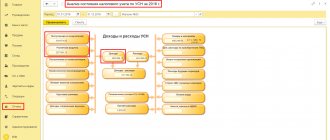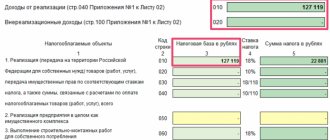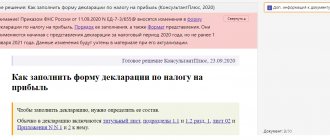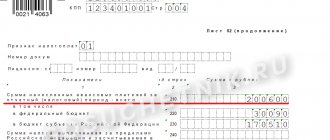Why compare income based on profit and VAT?
The answer is very simple - the tax office does this, which means we, accountants, need to do this too =)
Tax officials compare VAT and profit returns to find income that the company forgot to charge with VAT.
In the simplest case (if we are analyzing the 1st quarter of the reporting period and we have no accounting difficulties), to reconcile we just need to carefully look at both declarations and check lines 010 + 020 (Sheet 02) in Profit and line 010 (Section 3) in VAT returns.
And this is quite easy to do.
Difficulties begin if we need to compare indicators over 9 months or over a year. Profit is easy to calculate - it is indicated in the declarations on an accrual basis. But with VAT there is already a problem - reporting is quarterly, which means we need to take all declarations from the beginning of the year and summarize their indicators.
Now let’s add some more truths of life:
- refunds to suppliers (increase the VAT base, but no profit)
- customer returns (reduce income in profit, but not in VAT)
- VAT-free income
- different periods of income recognition for export sales
All this leads to the need to understand the discrepancies between VAT and profit
- becomes a very difficult task, requiring a deep dive into accounting, drawing up additional tables and additional checks.
Specialists have a lot of experience in finding VAT and profit differences using Excel tables and “working weekends,” but we are tired of searching everything by hand. We used all our knowledge and experience and developed a special report that allows you to automatically check the convergence of the VAT and Profit base
and take into account common discrepancies. And we are ready to share our findings.
Important: in addition to the adequate reasons for the differences between VAT and Profit, we often find accounting errors that distort the tax base. Our report removes all “resolved” discrepancies and allows you to focus on the actual errors.
Reviews about our work
| The processing is very cool! It helps a lot in my work and saves a lot of time. I use it quarterly for reporting. If there is a discrepancy between the tax bases for income tax and VAT, you can check it before submitting your reports and, if necessary, correct it. Previously, in order to check the compliance of the bases, it was necessary to raise the income tax for VAT for all periods of the current year, write down the numbers somewhere, add them up, and then only check them with the income tax income tax. And if you wrote it down incorrectly or someone was distracted at that moment, then the result will be incorrect. Now everything is done very quickly, you can say with one click of a button. The report shows exactly where the discrepancies are and it is very easy to find and check them. Accordingly, the response to the request of the Federal Tax Service is made quickly. Thanks to the developer! I recommend it to all accountants who work for OSNO! |
Before the appearance of this report, a large amount of time was spent checking the correctness of discrepancies between VAT and Income Tax revenues; now this task has been simplified to a minimum, which frees up time for other work, which is especially valuable during the reporting period.
Concept of a report comparing VAT and Income Tax indicators
- During the analysis, we compare data from regulated reports. Moreover, the report includes the latest adjustment declarations
- Program credentials are used to calculate allowed differences
- Indicators are calculated in full rubles
- “Allowed differences” are divided into two groups:
- Carryover differences (differences in the moment of income recognition)
- Constant differences
is zero.
Examples of using the report
Video review of the development
Let's consider the work of the report using the example of one year of the organization's work
1st quarter
In the 1st quarter we see the following situation:
- adjustment declarations are used for analysis (k/1)
- in this quarter, the VAT rate of 0% was confirmed for the amount of 10,878,485 rubles (for income tax purposes, these sales were taken into account in previous quarters)
- For sales in the amount of 3,730,529 rubles, the 0% rate has not yet been confirmed
Result: there are no erroneous differences, all differences are “allowed”
2nd quarter
This quarter we see a similar situation with differences, but the indicators are already considered both quarterly and cumulatively - to facilitate reconciliation. Please note that indicators that are obtained by calculation are highlighted in gray (you will not find these figures in the declarations).
3rd quarter
In the 3rd quarter we see a difference of 33,700 rubles. If you analyze all the data, you can find the reason for the difference - the presence of non-operating income not subject to VAT.
Setting up other income not subject to VAT
There is a special setting in the VAT and Profit reconciliation report that allows you to specify a list of non-operating expenses that should not be subject to VAT and that must be included in the “allowed” differences.
If an item of other income is added to this list, then the detail “Not subject to VAT” is filled in (it can also be set in the directory itself).
This allows you to build SALT for the 91st account, grouped by VAT taxability. By default, this list is filled with unambiguously “allowed” differences. The user can independently supplement the list. In this case, we will add the article “Insurance compensation (MTPL)” to the exceptions.
As a result, we will receive a report in which there are no unresolved differences
4th quarter
In the 4th quarter we see that a whole range of “allowed” differences have been taken into account:
- unconfirmed export 0%
- returns of goods to the supplier
- returns of goods from customers
- non-operating income not subject to VAT
And still we get an unresolved difference. In this case, it means the presence of an accounting error in the VAT or Profit return. Additional data analysis (outside the scope of this report) is required to identify the error. But our primary recommendation is to update the closing of months, the formation of a sales book and refill tax returns.
Courts' reasoning
In the professional literature there are often references to the fact that, according to the conclusions of such and such a Federal Antimonopoly Service, recognition of expenses for profit tax purposes is not a condition for deducting VAT on these expenses.
In this regard, it is curious about the Presidium of the Supreme Arbitration Court of the Russian Federation. Thus, when transferring the case to the Presidium, the panel of judges did not agree with the decision of the cassation instance. She, in turn, refused to deduct VAT due to the fact that the taxpayer did not provide evidence of incurring expenses under the lease agreements. The panel of judges indicated that the Code does not make the taxpayer's right to receive a tax deduction dependent on the validity of attributing expenses associated with his activities to expenses in accordance with Chapter. 25 of the Code (Definition of the Supreme Arbitration Court of the Russian Federation dated July 26, 2007 N 1238/07). However, the Presidium, not agreeing with the logic of the cassation instance, limited itself to substantive objections and did not reproduce the general formulation of its colleagues (Resolution of the Presidium of the Supreme Arbitration Court of the Russian Federation of October 23, 2007 N 1238/07).
Nevertheless, arbitration courts in disputes about the restoration of VAT indicate that this should be done only in cases expressly provided for in Art. 170 of the Tax Code of the Russian Federation (Decision of the Supreme Arbitration Court of the Russian Federation of October 23, 2006 N 10652/06).
Methodologically, the position that opposes the logic of the tax authorities is based on the need to be guided only by the direct and immediate norms of the Code, without resorting to their contextual, indirect interpretation.
Let's give an example. As you know, external improvement objects are not subject to depreciation for tax purposes (clause 4, clause 2, article 256 of the Tax Code of the Russian Federation). In this regard, guided by their logic described above, tax authorities refuse taxpayers to deduct VAT on such objects.
However, the courts, as a rule, do not agree with them, noting, in particular, that external improvement is carried out, as a rule, in compliance with the requirements of legislative or regulatory acts. It turns out that such landscaping, being directly related to office and industrial buildings and territory, is ultimately used for production purposes, that is, for carrying out operations subject to VAT (Resolution of the Federal Antimonopoly Service of the Moscow District dated January 26, 2009 N KA-A40/13294-08 , dated December 11, 2008 N KA-A40/11445-08, dated January 11, 2008 N KA-A40/13672-07, FAS West Siberian District dated September 17, 2008 N F04-5628/2008(11555 -A46-15)).
The same approach is applied by the courts in relation to VAT on non-operating expenses (Article 265 of the Tax Code of the Russian Federation). After all, by definition, non-operating expenses are also not used for the production and sale of goods (work, services), transfer of property rights, that is, for carrying out transactions subject to this tax. On this basis, regulatory authorities believe that VAT cannot be deducted on expenses, for example, on the liquidation of unfinished construction projects, conservation of fixed assets and their maintenance, holding a general meeting of shareholders (see Letter of the Ministry of Finance of Russia dated March 24, 2008 N 03 -07-11/106). However, the courts indicate that the listed expenses are directly related to the entrepreneurial and production activities of the taxpayer. Accordingly, the expenses go towards carrying out transactions recognized as objects of VAT taxation (Resolutions of the Federal Antimonopoly Service of the East Siberian District dated August 15, 2007 N A33-27276/05-Ф02-5437/07, Northwestern District dated April 4, 2008 in the case N A56-51219/2006).
Link to law. According to ch. 21 of the Code, the taxpayer has the right to deduct “input” VAT if the following conditions are met:
- if goods, work, services or property rights were acquired to carry out transactions subject to VAT (clause 2 of Article 171 of the Tax Code of the Russian Federation);
— VAT is accepted for deduction after goods, work, services or property rights are registered (clause 1 of Article 172 of the Tax Code of the Russian Federation);
— the tax deduction is applicable only if there is a correctly executed invoice (clause 1 of Article 172 of the Tax Code of the Russian Federation). The basis for the deduction is only a document that contains all the information provided for in paragraphs 5 and 6 of Art. 169 of the Code.
The cost of development is 6,000 rubles.
One year of free support (if the configuration is updated or the form changes, we will fix everything)
A year of additional support costs RUB 3,000.
Other information: The report was tested on versions: 1C: Enterprise Accounting 3.0.53 and higher
If necessary, we can provide paid consultations on identifying the differences between income tax and VAT.
If it is necessary to take into account individual nuances and modifications to work in changed configurations, the work is paid by the hour.
Tax arts
There are craftsmen who will offer to add fictitious services, for example, for 1,000,000 rubles received from a VAT payer organization. Then the amount of value added tax to be deducted will increase by 180,000 rubles (1,000,000 * 18%) and the amount due will be 360,000 - 90,000 (from point B) - 180,000 = 90,000 rubles.
In this case, no income tax will be paid at all, since the financial result will become negative – 300,000 – 1,000,000 = -700,000 rubles.
Are there legal ways to optimize taxation? These are not methods, but rather simply considerations dictated by common sense. The main recommendation for companies trying to whitewash themselves is that they need to work with VAT evaders when it is truly economically profitable.
That is, in this case there is a direct relationship: income tax has decreased, and VAT payable has also decreased.
Now let's look at the above figures through the eyes of an auditor, who will probably have questions and will need explanations about the legality of deductions and the fact of the loss itself. After all, no income tax is paid. And the business itself seems to lack a business goal - making a profit. Therefore, it is better to reject this optimization option.
A slightly less risky way to optimize VAT seems to be the option in which points B and D from our example are replaced by the services of VAT payers in the amount of 1,200,000 rubles, then a fee in the amount of 1,200,000 * 18 percent = 216,000 rubles is accepted for deduction.
In this case, the income tax remains equal to 300,000 * 20 percent = 60,000 rubles, and the VAT payable will be 360,000 - 216,000 - 90,000 = 54,000 rubles.
True, the indicated amount of 1,200,000 + 216,000 = 1,416,000 rubles will have to be “cashed out” in order to pay for points B and D. But even in this case, you need to prepare for tax claims regarding a fictitious payroll.
For a director who decides on such optimization, I will suggest another simple option for calculating VAT. That's profit multiplied by 18 percent. That is, 300,000 * 18 percent = 54,000 rubles. This optimization option is more or less safe for organizations whose share of wages in the cost of production is minimal.
Any manager is vaguely aware of these ways to reduce the tax burden, but now he can calculate the options himself. But in any case, each of the above examples carries a risk. And I am writing about them not so that you can apply them in practice, but to better understand the principles of the relationship of fees.
Updates
We provide new development versions free of charge within a year after purchase.
One year of additional support - 3,000 rubles. Attention, we do not guarantee the functionality of the development for which the additional support period has not been paid for.
The current version of the development can be obtained by writing to us by email. Managers will check whether you have access to support, send a new version or send an invoice.
Version 1.2
- interface fixes
Version 1.3
- the report has been prepared for use in cloud versions
- Fixed errors in report generation for users with limited rights
Version 1.4
- New indicators have been added to the allowed differences: Unconfirmed sales 0% (in case of additional VAT charges)
- Sales according to 90.01.1 without VAT
- Implementation according to 90.02.2 UTII and Patent
- the year-end closing mechanism was taken into account when analyzing accounts 90 and 91
- fixed determination of differences in returns to suppliers and from customers
Version 1.5
- Adjustments to sales taken into account (downward)
- Adjustments to sales downwards from sales from previous years have been taken into account
Version 1.6
- Added control for discrepancies in revenue and other income according to accounting data (90.01 and 91.01) and according to the profit declaration data
Version 1.7
- The 2021 analysis shows a VAT rate of 20%
- Corrected the indicator “Confirmed export sales” (Section 4 line 020) in the 2021 reports
- The difference of 1 ruble between SALT and the Profit Declaration is not controlled
Version 1.8
- We added revenue data for other operations (Appendix No. 3 to Sheet 02) to the analysis of the convergence of accounting and reporting data - this is usually the sale of fixed assets or intangible assets
- Added the ability to open regulated reports via hyperlink (in one click you can open everything you need for reconciliation)
- Added a description of the “Difference” column - the main reasons and necessary actions
Version 1.9
- This release adds checking for discrepancies in gratuitous transfer transactions
Version 1.10
- Added a new indicator “Shipment without transfer of ownership”
- Identified errors have been corrected
Version 1.11
- Added a new indicator “Sales of shipped goods” (actual transfer of ownership)
- We have finalized indicator 040 of section 4 of the VAT return. Now all the lines of this column are summed up
Version 1.12
We decided to make development even more convenient and transferred the functionality to the Extension. This will allow:
- more convenient to open development
- It’s more convenient to set up other income and expense items
- improve checking the compatibility of development with future versions of 1C:Accounting
But we haven’t forgotten about the development of functionality:
- We show differences only if there is something to show
- simplified setting up the item of other income from expenses (the “Not subject to VAT” flag)
- added a certificate for the indicator “Sales at a rate of 0%” (to open you need to click the “?” sign)
Version 1.13
- The extension is adapted to version 1C: Accounting 3.0.75
Version 1.14
The extension has been adapted to the new form of the regulated Profit report from the 4th quarter of 2021 (1C: Accounting 3.0.75)
Version 1.15
- added analysis of returns to the supplier (if it is made on the basis of an adjustment invoice)
- identified errors have been fixed
Version 1.16
- the long-awaited decoding of discrepancy indicators
- other income “Return of goods sold in the previous tax period” has been added to the default exceptions
Version 1.17
- Fixed minor inconvenience of adding other income
- Improved determination of the required declaration in the presence of separate divisions
Why accountants receive demands and how to respond to them
Let's figure out whether the discrepancies between profit and VAT are really an error, in what cases it is necessary to submit an updated declaration, and whether the inspectorate's requirements for providing explanations are legal.
In this article we consider the most common situations in which tax authorities have questions. There are a lot of special cases and it is impossible to make an exhaustive list.
Situation 1. Interest on a cash loan
Mental LLC received interest on the cash loan. Their receipt does not affect the VAT tax base, but is reflected in section 7 of the VAT return during the period of interest accrual (clause 1 of Article 146, clause 15 of clause 3 of Article 149 of the Tax Code of the Russian Federation). Interest received in profits accrues on the last day of each month (clause 6 of Article 250, clause 6 of Article 271 of the Tax Code of the Russian Federation).
How to give an explanation : There are no errors in the declaration. Discrepancies in the amount of 10,000 rubles arose due to non-operating income (loan interest) reflected in profit on line 100 of Appendix 1 to sheet 02 (clause 6 of Article 250 of the Tax Code of the Russian Federation). This amount was not included in the VAT tax base on the basis of clause 3 of Art. 149 and paragraph 1 of Art. 146 of the Tax Code of the Russian Federation.
Supporting documents : statements of accounts 90.01 “Revenue” and 91.01 “Other income”.
Situation 2. Sales of goods, works, services exempt from taxation
MedDvizhenie LLC sells medical products. They do not affect the tax base for VAT, but are reflected in section 7 of the VAT return (Article 149 of the Tax Code of the Russian Federation). The tax base for profit arises at the moment of transfer of ownership to the buyer. (Clause 3 of Article 271 of the Tax Code of the Russian Federation).
How to give an explanation : There are no errors in the declaration. In the 4th quarter of 2021, our organization sold medical products worth 10,000 rubles, which are not subject to VAT and are reflected in section 7 of the declaration (clause 1, clause 2, article 149 of the Tax Code of the Russian Federation). In the income tax return, this operation is reflected in lines 010, 011, 012 of the appendix to sheet 02 (clause 3 of article 271 of the Tax Code of the Russian Federation).
Supporting documents : purchase and sale agreement and registration certificate of medical devices.
How to save expenses and deductions?
Before sending, check the profit report with the VAT report.
Connect verification
Situation 3. Export operations
UkrepExport LLC sells goods to Kazakhstan. The accountant reflects export transactions in the VAT return in section 4 in the period when a complete package of documents has been collected (the period for collecting documents is 180 days) confirming export transactions (clause 9 of Article 167 of the Tax Code of the Russian Federation). In the income tax return, the tax base arises at the moment of transfer of ownership to the buyer (clause 3 of Article 271 of the Tax Code of the Russian Federation).
How to give an explanation : There are no errors in the declaration. In December 2021, our organization sold goods to Kazakhstan in the amount of 10,000 rubles. The tax base for profits was accrued at the moment of transfer of ownership of goods in the profit declaration for 2021 in lines 010, 011, 012 of the appendix to sheet 02 (clause 3 of article 271 of the Tax Code of the Russian Federation). And in the VAT return, this operation was reflected after receiving the full package of documents, for which 180 days were provided, namely 02/01/2020 and was reflected in the 1st quarter of 2020 in section 4 of the VAT return. (clause 9 of article 167 of the Tax Code of the Russian Federation).
Supporting documents : sales contract with specifications, bill of lading or acceptance certificate.
Situation 4. Receiving dividends and interest on deposits
Gloria LLC invested money in another legal entity and receives dividends. When determining the tax base for VAT, they do not participate and are not reflected in the declaration (clause 1 of Art., subclause 1 of clause 1 of Article 146 of the Tax Code of the Russian Federation). In profit, income arises at the time of receipt of money (clause 8 of article 250, clause 1 of article 271 of the Tax Code of the Russian Federation).
How to give an explanation : In December 2021, our organization received dividends in the amount of 10,000 rubles, which are reflected in the income tax return in line 100 of Appendix 1 to sheet 02, in line 070 of sheet (clause 8 of article 250, clause 1 of art. 271 of the Tax Code of the Russian Federation). This operation is not involved in the calculation of the tax base for VAT and is not reflected in the declaration (clause 1 of Art., subclause 1 of clause 1 of Article 146 of the Tax Code of the Russian Federation).
Supporting documents : decision to pay dividends, payment orders or cash documents for payment of dividends.
Situation 5. Positive exchange differences
Sea of Krill LLC entered into a supply agreement to Kazakhstan with partial payment. The amount of VAT was calculated on the currency advance at the rate of the Central Bank of the Russian Federation on the date of shipment. Upon receipt of subsequent payment, a positive exchange rate difference was formed.
In the VAT tax return, the positive exchange rate difference is not calculated and not reflected (clause 1, clause 1, article 146 of the Tax Code of the Russian Federation). But it is taken into account when forming the tax base for profit at the time of revaluation of liabilities (clause 8 of Article 271, clause 10 of Article 272 of the Tax Code of the Russian Federation).
How to give an explanation : There are no errors in the declaration. Our organization entered into a supply agreement with partial payment to Kazakhstan. The amount of VAT was charged on the foreign currency advance, at the Bank of Russia exchange rate in effect on the date of shipment. Upon receipt of subsequent payment, the positive exchange rate difference was included in non-operating income for income tax and is reflected in line 100 of Appendix 1 to Sheet 2 (clause 8 of Article 271, clause 10 of Article 272 of the Tax Code of the Russian Federation). Thus, the tax base for income tax and VAT differs by the amount of exchange rate differences, since these amounts are not reflected in the VAT return (clause 1, clause 1, article 146 of the Tax Code of the Russian Federation).
Supporting documents : statements of account 62 for subaccounts “Settlements for advances received”, “Settlements for goods shipped”; under account 91.1 “Other income”.
Situation 6. Free transfer of goods, works, services, property rights
Dam in Dar LLC donated goods worth 10,000 rubles. The tax base for VAT arose at the time of transfer of goods (clause 1 of Art., clause 1 of clause 1 of Article 146 of the Tax Code of the Russian Federation). But there was no tax base for profit, so the accountant did not reflect it in the declaration (Article 249, Article 250 of the Tax Code of the Russian Federation).
How to give an explanation : There are no errors in the declaration. In the 4th quarter of 2021, our organization donated goods to third parties in the amount of 10,000 rubles and reflected these transactions in the VAT return for the corresponding period in line 030 of section 3 (010, 020 depending on the tax rate) (clause 1, clause 1 Article 146 of the Tax Code of the Russian Federation). The tax base for profit did not arise and is not reflected in the profit declaration (Article 249, Article 250 of the Tax Code of the Russian Federation).
Supporting documents : statement of account 91.02 “Other expenses” and an agreement under which one party undertakes to provide something to the other party without receiving payment or other counter-provision from it.
Situation 7. Free receipt of goods, works, services, property rights
Surprise LLC received goods worth 10,000 rubles as a gift from a counterparty. The tax base for VAT did not arise; the accountant did not reflect the operation in the declaration (clause 1, clause 1, article 146 of the Tax Code of the Russian Federation). In the income tax return, income arises at the time of receipt of goods (clause 8 of Article 250, clause 1 of clause 4 of Article 271 of the Tax Code of the Russian Federation).
How to give an explanation : There are no errors in the declaration. In the 4th quarter of 2021, our organization received goods worth 10,000 rubles free of charge and reflected this operation in the profit declaration in line 100, 103 of Appendix 1 to Sheet 02. (Clause 8 of Article 250, Clause 1 of Clause 4 of Art. 271 of the Tax Code of the Russian Federation). The tax base for VAT did not arise and is not reflected in the declaration (clause 1, clause 1, article 146 of the Tax Code of the Russian Federation).
Supporting documents : statement of account 98.2 “Gratuitous receipts”.
Situation 8. Carrying out construction and installation work for own consumption
Sami with a Mustache LLC was building a warehouse for itself. The income arose during the formation of the tax base for VAT and was reflected in the declaration at the end of each quarter (clause 3, clause 1, article 146 of the Tax Code of the Russian Federation). It was not included in the income tax base and was not reflected in the declaration.
How to give an explanation : There are no errors in the declaration. In 2019, our organization built a real estate property for its own consumption and reflected these operations in the VAT return for each quarter in line 060 of section 3 (clause 3, clause 1, article 146 of the Tax Code of the Russian Federation). The tax base for the profit did not arise and is not reflected in the profit declaration.
Supporting documents : statement of accounts 01 “Fixed Assets”; 08.03 “Construction of fixed assets”.
Situation 9. Based on the inventory results, surplus was capitalized
LLC "Skladskoy zapas" identified surplus wooden pallets based on the results of the inventory. The identified surpluses are not included in the VAT tax base and are not reflected in the declaration (clause 1, clause 1, article 146 of the Tax Code of the Russian Federation). In income tax, they arise at the time the inventory is completed (clause 20, article 250, clause 1, article 271 of the Tax Code of the Russian Federation).
How to give an explanation : There are no errors in the declaration. Surplus inventory items identified as a result of the inventory are included in non-operating income and reflected in the income tax return in the amount of 10,000 rubles on line 104 of Appendix 1 to Sheet 02 (clause 20 of Article 250 of the Tax Code of the Russian Federation). At the same time, the object of VAT taxation did not arise at the time of capitalization of the surplus (clause 1 of Article 146 of the Tax Code of the Russian Federation).
Supporting documents : act of the inventory commission and statement of account 91 “Other income and expenses.”
Situation 10. Accounts payable are written off due to the expiration of the statute of limitations
Possibility LLC wrote off the debt to the counterparty because the statute of limitations had expired. The write-off amount does not require restoration in the VAT return and does not fall into the tax base. (Letter of the Ministry of Finance of Russia dated June 21, 2013 No. 03-07-11/23503, resolution of the Central District Administrative Court dated August 1, 2017 in case No. A48-3674/2016) . But it is subject to inclusion in non-operating income for profit tax (clause 18 of article 250 of the Tax Code of the Russian Federation)
How to give an explanation : There are no errors in the declaration. Discrepancies in the amount of 10,000 rubles arose due to non-operating income (the amount of overdue accounts payable including VAT) reflected in the income statement on line 100 of Appendix 1 to sheet 02 (clause 18 of Article 250 of the Tax Code of the Russian Federation). This amount was not included in the VAT tax base on the basis of clause 3 of Art. 149 and paragraph 1 of Art. 146 of the Tax Code of the Russian Federation.
Supporting documents : statements of accounts 90.01 “Revenue” and 91.01 “Other income”.
Situation 11. Sales of recyclable materials by the VAT payer
Rudnik LLC sold scrap metal to Tekhstroy LLC. Both organizations are VAT payers. Scrap metal is intended for use by Tekhstroy in activities subject to VAT. In this case, it is not the seller who must charge VAT, but the buyer-tax agent. The seller will issue an invoice to the buyer with the note “VAT is calculated by the tax agent.” The buyer will reflect in the declaration all transactions related to the calculation and deduction of VAT when shipping scrap metal. The seller’s operation will not be included in the VAT tax base. But it will be reflected in the income tax return on lines 010, 011, 012, 014 of Appendix 1 to Sheet 2.
How to give an explanation : We sold scrap metal according to invoice No. 1 with the note “VAT is calculated by the tax agent.” This operation is not included in the VAT return and is not included in the calculation of the tax base (clause 8 of Article 161 of the Tax Code of the Russian Federation). In the income tax return, the sale of scrap metal is reflected in lines 010, 011, 012, 014 of Appendix 1 to Sheet 2 (clause 3 of Article 271 of the Tax Code of the Russian Federation).
Supporting documents : invoice with the note “VAT is calculated by the tax agent.”
Exception when the seller pays VAT:
- The VAT payer illegally entered o. in the contract and primary documents.
- The seller has lost the right to use the simplified tax code or UTII.
- The seller has lost the right to VAT exemption.
- The VAT payer sold the goods to an individual without individual entrepreneur status.
- The VAT payer sold recyclable materials for export.
Situation 12. Return of previously purchased goods
Domino LLC purchased goods that were later found to be defective. The company provided the supplier with a statement of defects in the goods and a return receipt. The seller issued an adjustment invoice for the reduction and recorded it in the purchase ledger. For income tax purposes, income was reduced by the proceeds from the sale of the defect, and expenses by its cost. The buyer registered an entry in the sales book, thereby reflecting the tax base in the VAT return. The operation was not included in the profit declaration because it was not income.
How to give an explanation : There are no errors in the declaration. The defective product was returned to the supplier. Funds received from the supplier are not included in income, and the cost of goods to be returned is not taken into account in expenses. VAT will be charged on the cost of the returned goods. The discrepancies arose because there was no income for income tax purposes, and VAT was accrued on line 010 (020) and in columns 3 and 5 of section 3 of the declaration (clause 1 of article 146 of the Tax Code of the Russian Federation). A new contract was not concluded, but the original contract between the organization and the supplier was terminated.
Supporting documents : statement of product defects, return receipt, adjustment invoice.
Exception . If goods are returned to a supplier at the organization’s initiative, the organization receives taxable income when calculating income tax, which can be reduced by the cost of the goods being returned. VAT is charged on sales proceeds. Since the refund occurs at supplier prices, the revenue for the purposes of calculating income tax and VAT will be the same.
Situation 13. Penalties not related to payment for goods, works, services
The buyer has violated the terms of the contract providing for the supply of goods subject to VAT and is obliged to pay a penalty (fines, penalties) to the seller. The amount of the penalty (liability for delay in fulfilling obligations) received by the organization from the counterparty under the contract is not related to payment for the goods in the sense of the provisions of Art. 162 of the Tax Code of the Russian Federation, therefore not subject to VAT. It is not reflected in the VAT return (letter of the Ministry of Finance dated March 4, 2013 No. 03-07-15/6333), but is included in the tax base for profits and is reflected in line 100 of Appendix 1 to sheet 02 (clause 3 of Article 250, subparagraph 4, paragraph 1, article 271 of the Tax Code of the Russian Federation).
How to give an explanation : There are no errors in the declaration. The amount of the penalty we received under the agreement with the counterparty Yantar LLC was taken into account as part of non-operating income and reflected in the income tax return in the amount of 10,000 rubles on line 100 of Appendix 1 to Sheet 02 (clause 3 of Article 250, subclause 4 Clause 1 of Article 271 of the Tax Code of the Russian Federation). Moreover, this operation is not subject to VAT (letter of the Ministry of Finance dated March 4, 2013 No. 03-07-15/6333).
Supporting documents : supply agreement with calculation of penalties and statement of account 91.01 “Other income”.
Situation 14. Restoration of a previously created reserve provided for in Chapter 25 of the Tax Code of the Russian Federation
At LLC LUCH, the amount of the reserve for doubtful debts formed at the end of the reporting period was less than the amount of the balance of the reserve. The difference was included in non-operating income and reflected in line 100 of Appendix 1 to Sheet 2 of the income tax return. The restoration of a previously created reserve is not reflected in the VAT tax base and is not included in the declaration.
How to give an explanation : There are no errors in the declaration. The amount of the reserve calculated as of the reporting date is less than the amount of the reserve balance of the previous reporting period. The difference was included in non-operating income on line 100 of Appendix 1 to sheet 02 of the income tax return (clause 7 of Article 250, subclause 5 of clause 4 of Article 271 of the Tax Code of the Russian Federation). The restoration of a previously created reserve is not reflected in the VAT tax base and is not included in the declaration. (Subclause 1, Clause 1, Article 146 of the Tax Code of the Russian Federation)
Supporting documents : statement of account 91 “Other income and expenses”.
If the calculations in the declaration are correct and the taxes are calculated correctly, and the difference between the revenue figures is caused by different requirements for the procedure for calculating income tax and VAT, clarification is not required. The response to the request will be an explanation.
The requirement for a discrepancy between the tax base of profit and VAT does not come every quarter and not for every submitted declaration, even if the bases diverge quarterly. The fact is that this requirement is not automated; tax authorities send them out manually after sampling. This usually occurs after the end of the calendar year, the submission of VAT returns for refund, and also during an on-site inspection.






